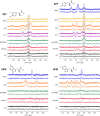Direct Expression of Fluorinated Proteins in Human Cells for 19F In-Cell NMR Spectroscopy
- PMID: 36604341
- PMCID: PMC9853860
- DOI: 10.1021/jacs.2c12086
Direct Expression of Fluorinated Proteins in Human Cells for 19F In-Cell NMR Spectroscopy
Abstract
In-cell NMR spectroscopy is a powerful approach to study protein structure and function in the native cellular environment. It provides precious insights into the folding, maturation, interactions, and ligand binding of important pharmacological targets directly in human cells. However, its widespread application is hampered by the fact that soluble globular proteins often interact with large cellular components, causing severe line broadening in conventional heteronuclear NMR experiments. 19F NMR can overcome this issue, as fluorine atoms incorporated in proteins can be detected by simple background-free 1D NMR spectra. Here, we show that fluorinated amino acids can be easily incorporated in proteins expressed in human cells by employing a medium switch strategy. This straightforward approach allows the incorporation of different fluorinated amino acids in the protein of interest, reaching fluorination efficiencies up to 60%, as confirmed by mass spectrometry and X-ray crystallography. The versatility of the approach is shown by performing 19F in-cell NMR on several proteins, including those that would otherwise be invisible by 1H-15N in-cell NMR. We apply the approach to observe the interaction between an intracellular target, carbonic anhydrase 2, and its inhibitors, and to investigate how the formation of a complex between superoxide dismutase 1 and its chaperone CCS modulates the interaction of the chaperone subunit with the cellular environment.
Conflict of interest statement
The authors declare no competing financial interest.
Figures





Similar articles
-
Controlling the incorporation of fluorinated amino acids in human cells and its structural impact.Protein Sci. 2024 Mar;33(3):e4910. doi: 10.1002/pro.4910. Protein Sci. 2024. PMID: 38358125 Free PMC article.
-
Ligand-Based Competition Binding by Real-Time 19F NMR in Human Cells.J Med Chem. 2024 Jan 25;67(2):1115-1126. doi: 10.1021/acs.jmedchem.3c01600. Epub 2024 Jan 12. J Med Chem. 2024. PMID: 38215028 Free PMC article.
-
In-Cell NMR in Human Cells: Direct Protein Expression Allows Structural Studies of Protein Folding and Maturation.Acc Chem Res. 2018 Jun 19;51(6):1550-1557. doi: 10.1021/acs.accounts.8b00147. Epub 2018 Jun 5. Acc Chem Res. 2018. PMID: 29869502
-
Insights into the Structure and Dynamics of Proteins from 19F Solution NMR Spectroscopy.Biochemistry. 2024 Nov 19;63(22):2958-2968. doi: 10.1021/acs.biochem.4c00534. Epub 2024 Nov 4. Biochemistry. 2024. PMID: 39495741 Review.
-
Fluorine Labeling and 19F NMR Spectroscopy to Study Biological Molecules and Molecular Complexes.Chemistry. 2025 Jan 9;31(2):e202402820. doi: 10.1002/chem.202402820. Epub 2024 Nov 18. Chemistry. 2025. PMID: 39466678 Review.
Cited by
-
Protein structure and interactions elucidated with in-cell NMR for different cell cycle phases and in 3D human tissue models.Commun Biol. 2025 Feb 7;8(1):194. doi: 10.1038/s42003-025-07607-w. Commun Biol. 2025. PMID: 39920376 Free PMC article.
-
Rational design of 19F NMR labelling sites to probe protein structure and interactions.Nat Commun. 2025 May 8;16(1):4300. doi: 10.1038/s41467-025-59105-6. Nat Commun. 2025. PMID: 40341366 Free PMC article.
-
Leveraging relaxation-optimized 1H-13CF correlations in 4-19F-phenylalanine as atomic beacons for probing structure and dynamics of large proteins.Nat Chem. 2025 Jun;17(6):835-846. doi: 10.1038/s41557-025-01818-8. Epub 2025 May 5. Nat Chem. 2025. PMID: 40325144
-
Progress, Challenges and Opportunities of NMR and XL-MS for Cellular Structural Biology.JACS Au. 2024 Feb 5;4(2):369-383. doi: 10.1021/jacsau.3c00712. eCollection 2024 Feb 26. JACS Au. 2024. PMID: 38425916 Free PMC article. Review.
-
Real-Time Monitoring of the Level and Activity of Intracellular Glutathione in Live Cells at Atomic Resolution by 19F-NMR.ACS Cent Sci. 2023 Jul 21;9(8):1623-1632. doi: 10.1021/acscentsci.3c00385. eCollection 2023 Aug 23. ACS Cent Sci. 2023. PMID: 37637729 Free PMC article.
References
Publication types
MeSH terms
Substances
LinkOut - more resources
Full Text Sources

